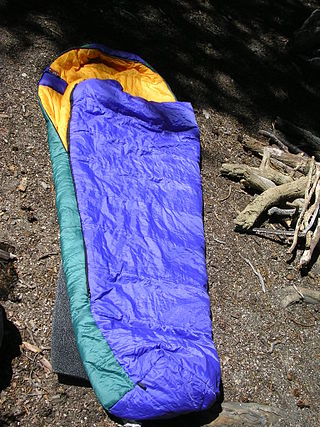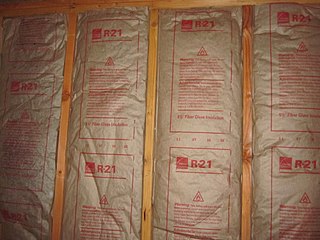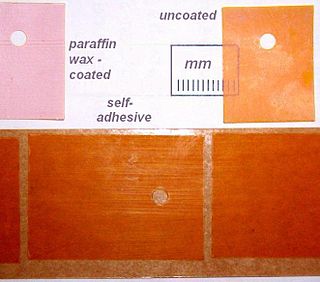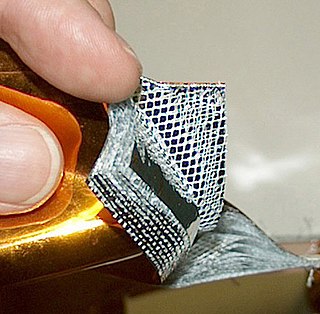
Thermal insulation is the reduction of heat transfer between objects in thermal contact or in range of radiative influence. Thermal insulation can be achieved with specially engineered methods or processes, as well as with suitable object shapes and materials.

BoPET is a polyester film made from stretched polyethylene terephthalate (PET) and is used for its high tensile strength, chemical and dimensional stability, transparency, reflectivity, gas and aroma barrier properties, and electrical insulation. A variety of companies manufacture boPET and other polyester films under different brand names. In the UK and US, the best-known trade names are Mylar, Melinex, Lumirror and Hostaphan.

A sleeping bag is an insulated covering for a person, essentially a lightweight quilt that can be closed with a zipper or similar means to form a tube, which functions as lightweight, portable bedding in situations where a person is sleeping outdoors. It is also commonly used indoors for people who do not have beds or at sleepovers. Its primary purpose is to provide warmth and thermal insulation through its synthetic or down insulation. It also typically has a water-resistant or water-repellent cover that protects, to some extent, against wind chill and light precipitation, but a tent is usually used in addition to a sleeping bag, as it performs those functions better. The bottom surface also provides some cushioning, but a sleeping pad or camp cot is usually used in addition to that purpose. The bottom surface of a sleeping bag may be moderately water repellent, but a plastic tarp or groundsheet is often used to protect against moist ground.

In the context of construction, the R-value is a measure of how well a two-dimensional barrier, such as a layer of insulation, a window or a complete wall or ceiling, resists the conductive flow of heat. R-value is the temperature difference per unit of heat flux needed to sustain one unit of heat flux between the warmer surface and colder surface of a barrier under steady-state conditions. The measure is therefore equally relevant for lowering energy bills for heating in the winter, for cooling in the summer, and for general comfort.

A radiant barrier is a type of building material that reflects thermal radiation and reduces heat transfer. Because thermal energy is also transferred by conduction and convection, in addition to radiation, radiant barriers are often supplemented with thermal insulation that slows down heat transfer by conduction or convection.

Kapton is a polyimide film used in flexible printed circuits and space blankets, which are used on spacecraft, satellites, and various space instruments. Invented by the DuPont Corporation in the 1960s, Kapton remains stable across a wide range of temperatures, from 4 to 673 K. Kapton is used in electronics manufacturing, space applications, with x-ray equipment, and in 3D printing applications. Its favorable thermal properties and outgassing characteristics result in its regular use in cryogenic applications and in situations where high vacuum environments are experienced.

Polyimide is a polymer containing imide groups belonging to the class of high-performance plastics. With their high heat-resistance, polyimides enjoy diverse applications in roles demanding rugged organic materials, such as high temperature fuel cells, displays, and various military roles. A classic polyimide is Kapton, which is produced by condensation of pyromellitic dianhydride and 4,4'-oxydianiline.

A voice coil is the coil of wire attached to the apex of a loudspeaker cone. It provides the motive force to the cone by the reaction of a magnetic field to the current passing through it.

The Space Shuttle thermal protection system (TPS) is the barrier that protected the Space Shuttle Orbiter during the searing 1,650 °C (3,000 °F) heat of atmospheric reentry. A secondary goal was to protect from the heat and cold of space while in orbit.
Low emissivity refers to a surface condition that emits low levels of radiant thermal (heat) energy. All materials absorb, reflect, and emit radiant energy according to Planck's law but here, the primary concern is a special wavelength interval of radiant energy, namely thermal radiation of materials. In common use, especially building applications, the temperature range of approximately -40 to +80 degrees Celsius is the focus, but in aerospace and industrial process engineering, much broader ranges are of practical concern.

Building insulation is material used in a building to reduce the flow of thermal energy. While the majority of insulation in buildings is for thermal purposes, the term also applies to acoustic insulation, fire insulation, and impact insulation. Often an insulation material will be chosen for its ability to perform several of these functions at once.
Insulative paints, or insulating paints, are a specially designed type of paint in which can be used to coat a surface to reduce heat transfer as well as increase the thermal insulating property (R-value in order to aid cooling and heating efforts for example.Insulative paints use a technology where a broad spectrum thermally reflective coating is applied to a specific type of micro-spheres to block heat radiation in a larger range of thermal energy to dissipate heat rapidly. This type of coated thermally reflective material reduces heat transfer through the coating with 90% of solar infrared radiation and 85% of ultraviolet radiation being radiated back from the coated surface[1]

Multi-layer insulation (MLI) is thermal insulation composed of multiple layers of thin sheets and is often used on spacecraft and cryogenics. Also referred to as superinsulation, MLI is one of the main items of the spacecraft thermal design, primarily intended to reduce heat loss by thermal radiation. In its basic form, it does not appreciably insulate against other thermal losses such as heat conduction or convection. It is therefore commonly used on satellites and other applications in vacuum where conduction and convection are much less significant and radiation dominates. MLI gives many satellites and other space probes the appearance of being covered with gold foil which is the effect of the amber-coloured Kapton layer deposited over the silver Aluminized mylar.

An (Integrated) Thermal Micrometeoroid Garment is the outer layer of a space suit. The TMG has three functions: to insulate the suit occupant and prevent heat loss, to shield the occupant from harmful solar radiation, and to protect the astronaut from micrometeoroids and other orbital debris, which could puncture the suit and depressurize it.

Building insulation materials are the building materials that form the thermal envelope of a building or otherwise reduce heat transfer.
Metallised films are polymer films coated with a thin layer of metal, usually aluminium. They offer the glossy metallic appearance of an aluminium foil at a reduced weight and cost. Metallised films are widely used for decorative purposes and food packaging, and also for specialty applications including insulation and electronics.

LI-900 is a type of reusable surface insulation tile developed and manufactured by Lockheed Missiles and Space Company in Sunnyvale, California. It was designed for use on the Space Shuttle orbiter as part of its thermal protection system to minimize thermal conductivity while providing maximum thermal shock resistance.
Upilex is a heat-resistant polyimide film that is the product of the polycondensation reaction between biphenyl tetracarboxylic dianhydride (BPDA) monomers and a diamine. Its properties include dimensional stability, low water absorption, high chemical resistance and high mechanical properties, high heat and chemical resistance. It was developed by UBE Industries. Upilex-S is the standard grade but other grades include Upilex-RN, VT, CA and SGA. Upilex-S is used when excellent mechanical properties are required. Upilex-RN possesses excellent molding processability, while Upilex-VT has superior heat bonding characteristics. General applications of Upilex include their use in flexible printed circuits, electric motor and generator insulation, high temperature wire and cable wrapping, and specialty pressure sensitive tapes. Polyimides have also been extensively studied in gas and humidity sensors, where the concentration is determined by monitoring the capacitance of modified Upilex films. With advantages of flexibility and easy functionalization, Upilex films are often used as substrate materials in biosensor platforms. For instance, it is possible to electropolymerize onto these films or attach enzymes to it for the detection of glucose.

A radiator reflector is a thin sheet or foil applied to the wall behind, and closely spaced from, a domestic heating radiator. The intention is to reduce heat losses into the wall by reflecting radiant heat away from the wall. It is a form of radiant barrier and is intended to reduce energy losses and hence decrease fuel expenditure.

In spacecraft design, the function of the thermal control system (TCS) is to keep all the spacecraft's component systems within acceptable temperature ranges during all mission phases. It must cope with the external environment, which can vary in a wide range as the spacecraft is exposed to the extreme coldness found in the shadows of deep space or to the intense heat found in the unfiltered direct sunlight of outer space. A TCS must also moderate the internal heat generated by the operation of the spacecraft it serves.



















